MOJ
eISSN: 2574-9722


Research Article Volume 8 Issue 2
1Genetics Department, Faculty of Agriculture, Sohag University, Egypt
2Bitechnology Branch, Faculty of Agriculture, Sohag University, Egypt
Correspondence: Haitham MA Elsayed, Genetics Department, Faculty of Agriculture, Sohag University, Egypt
Received: March 06, 2023 | Published: April 12, 2023
Citation: Ismail E, Ahmed RB, Aboelkassem AA, et al. Response of early seedling inberd lines of wheat against 20% PEG6000 induced condition. MOJ Biol Med. 2023;8(2):45-48. DOI: 10.15406/mojbm.2023.08.00182
At the germination and seedling stages, the drought resistance of six genotypes of winter wheat was investigated under lab condition. PEG6000 was employed in research under controlled circumstances to simulate drought stress at 20% concentration. Our finding showed that the inbred lines (Sakha-94 x Misr-1) and (Weiber x Sids-12) demostrated highest drought tolerant. In order to achieve high yield under water stress, these lines have a great deal of potential to be incorporated with the current commercial wheat types.
Keywords: wheat lines, germination, PEG6000
Seed germination, the first stage of growth, is susceptible to water scarcity because soil moisture at the time of planting may hinder seedling emergence, which in turn affects yield output.1,2 Due to a water deficit, plant physiological and biochemical processes as well as growth and development may all be significantly impacted.3 The plant integrates a variety of responses and adaptive mechanisms at the morphological, physiological, and molecular levels to respond to drought stress.4 Yet, the use of these systems varies significantly between different plant species or genotypes within a species. When there is a water shortage early on plants, typically have the capacity to efficiently absorb water from the soil through their root systems, partly close their stomata to reduce water loss through transpiration, and change their metabolism to accommodate the available carbon resource.5,6 Prolines, soluble sugars, spermines, and betaine are examples of osmolytic substances that build in plant cells as stress levels rise to maintain the cell turgor pressure.7 Therefore, the physical and molecular reactions that occur when plants respond to drought involve a variety of biological macro and micro molecules, including nucleic acids (DNA, RNA, and microRNA), proteins, carbohydrates, lipids, hormones, ions, free radicals, and mineral elements.8
Due to PEG6000 high molecular weight it is used for seedling stage selection for drought tolerance genotypes.9 PEG6000 molecules are too large to be absorbed by plants, too small to affect osmotic potential, and even too massive to be anticipated to quickly penetrate intact plant tissues.10 Because PEG does not penetrate the apoplast, water is withdrawn from the cell, making PEG6000 solution more like dry soil than other solutions.11
The goal of this study was to determine whether there were differences in the responses of six winter wheat inbred lines to water stress in order to be grown in marginal and dry land by estimating several morphological drought resistance parameters under PEG6000 as a water deficiency at early seedling stage.
Six wheat genotypes made up the experimental materials for this investigation (Table 1). The seeds were collected from Genetics Dept., Faculty of Agric., Sohag Univ., Sohag, Egypt. These genotypes were directly seeded in mositen petri dishes, and their drought tolerance and various root and shoot characteristics were assessed over the interval of three replications.
Lines No. |
Lines Source |
1 |
Misr-1 X Sids-12 |
2 |
Weiber X Sids-12 |
3 |
Katela X Sakha-94 |
4 |
Weiber X Misr-1 |
5 |
Katela X Sids-12 |
6 |
Sakha-94 X Misr-1 |
Table 1 List of wheat inbred lines used for present investigation
Mean performance was recorded for seedling length, root numbers, seedling fresh weight, seedling dry weight, germination percentage, vigor index and tissue water content.
Preparation of priming solution
Drought-stressed plants were watered daily with a 20% PEG6000 solution (dissolving 20 gm of PEG6000 in 100 ml of purified water), which was applied for 15 days.
Seed placement for germination
The surface of each seed was sterilised with 5% sodium hybochloride soultion for 20 mins, followed by a sterile water rinse and room temperature air drying. The priming media was made in 20% PEG6000 solution and distilled water, and it was primed for nine hours. Seeds that had been soaked were then air dried and put in petridish. For each replicate, 15 seeds were put in a petri dish with a diameter of 90 cm, layered with filter paper moistened with 10 ml of 20% PEG6000, and exposed to conditions that included a photoperiod of 114 hours, 250 µmole-2s-1 day/night temperature of 25ºC, and a relative humidity of 60/75%.
Experimental design
Three replications were used in the experiment's Complete Randomized Design (CRD). The eximend wheat lines presented in Table 1 under primed seed with 20% PEG6000 soultion.
Recording data
Considering the data collection for different parameters, the mean data of seedling length, root numbers, Seedling fresh weight, seedling dry weight, germination percentage, vigor index12 and tissue water content (Muscolo et al., 2013) were recorded after 15 days of planting seeds. In each petri dishes ten seedlings were evaluated. Shoot and root length of single seedling were measured using a ruler and metre scale two weeks after seeding. After that, each seedling's roots were numbered. The seedling's shoot and root were then dried for 48 hours, and their dry weights were registered using an electric scale.
Statistical analysis
The collected CRD design data was used to statistically analysis by Excel software.
The process and trait of plant drought resistance is quite complicated. Drought resistance in plants is correlated with a number of activities at specific developmental stages, including stomatal movement, photosynthesis, cell osmotic regulation, synthesis of protective macromolecules, and antioxidant synthesis. Plant growth and development are typically quite vulnerable to water sacrificial mechanisms13 it might cause significant increase in electrolyte leakage from leaves. Keeping a high water content gave researchers the chance to study physiological processes both during droughts and after rehydrating plants. When there is a water shortage in early plants stage, typically have the capacity to efficiently absorb water from the soil through their root systems, partially close their stomata to limit water loss through transpiration, and change their metabolism to adapt the available carbon resource.5,6 Consequently, determining drought resistance is significantly harder and more complicated than determining other stress resistances.14
Mean values regarding seedling length under 20% PEG6000 are presented in Figure 1. The highest seedling length was recorded in (Sakha-94 X Misr-1). Ahmad et al.,15 and Baque et al.,16 reported that when the seeds were induced with a 10% PEG6000 solution, the highest seedling length of wheat was secured.

Figure 1 Effect of 20% PEG6000 on Seedling Length of tested wheat inbred lines (all means [± S.E.] are significantly different at P<0.05).
When plants are subjected to drought stress in the soil, the roots become the first organ to experience. According to the presented invetigation, the majority of the examined inbred lines were affected by drought stress as exhbited in Figure 2. Fenta et al.,17 stated that an important factor in determining a plant's capacity to extract essential resources from the soil, such as water and mobile nutrients, is the distribution of roots, particularly those that can reach deeper into the soil. Hence, root architecture has a significant impact on the development and productivity of crop plants.
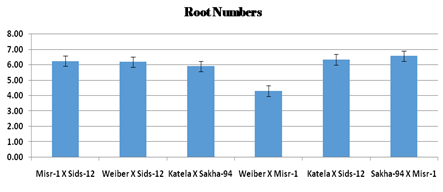
Figure 2 Effect of 20% PEG6000 on Root Numbers of tested wheat inbred lines (all means [± S.E.] are significantly different at P<0.05).
Germination percentage signifcantly affaected by 20% level PEG6000 resulted declined progressively under 20% PEG6000 in all six inbred lines. The inbred line (Katela X Sakha-94) demonstrated the highest level of tolerance, and the rate of decline was low relative to the other lines (Figure 3). Similar to this, Jatoi et al.,9 found that 25% PEG induced a distract reduction, while 19% PEG caused a reduction in germination percentage, which refere to early seedling germination stage water deficit stress causes delayed and reduced germination. This is consistent with Ashraf & Abu-Shakra's18 research, which found that at low moisture levels, germination percentage and seedling growth both decreased.
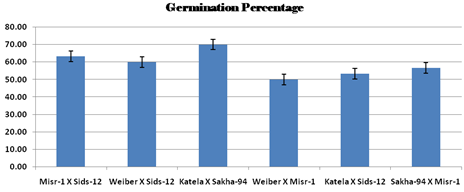
Figure 3 Effect of 20% PEG6000 on Germination Percentage of tested wheat inbred lines (all means [± S.E.] are significantly different at P<0.05).
Seedling fresh and dry weights were significantly decreased under 20% PEG6000 (Figures 4 and 5). The seedling fresh weight was highest in (Weiber X Sids-12) and (Sakha-94 X Misr-1). While, the variation in seedling dry weight was observed, and the results showed that (Katela X Sakha-94) was constantly decreased value, that is caused by the treatment. And So far, other genotypes reacted to the observations in various ways. Sayar et al.,19 reported that when osmotic potential increased, the fresh weight of seedlings of both drought-tolerant and sensitive durum wheat genotypes decreased. Numerous other scientists have noted the declining trend in seedling fresh and dry weight, Chachar et al.20; Kamran et al.21; Moucheshi et al.22 and Ahmad et al.23) who showed that the fresh and dried weight of seedlings was significantly impacted by water stress.
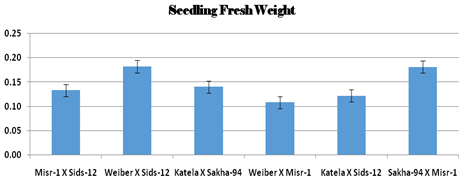
Figure 4 Effect of 20% PEG6000 on Seedling Fresh Weight of tested wheat inbred lines (all means [± S.E.] are significantly different at P<0.05).
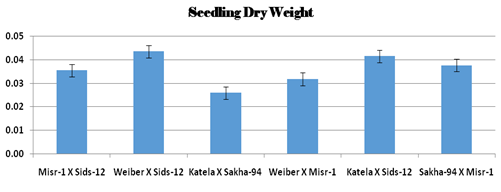
Figure 5 Effect of 20% PEG6000 on Seedling Dry Weight of tested wheat inbred lines (all means [± S.E.] are significantly different at P<0.05).
The vigor index and tissue water content values were affected by the level of 20% PEG6000. The highest vigor index were presented in (Sakha-94 x Misr-1) (Figure 6). Meanwhile, the values regarding tissue water content responded differently to the observations (Figure 7). Hassan et al.24; El-Hamamsy and Behairy,25 and Alamri et al.26 illustrated that seedling vigor traits and tissue water content decreased with increasing of PEG and NaCl concentrations. Biesaga-Kościelniak et al.,27 reported that wheat seedlings under drought stress had considerably decreased growth vigour.

Figure 6 Effect of 20% PEG6000 on Vigor Index of tested wheat inbred lines (all means [± S.E.] are significantly different at P<0.05).
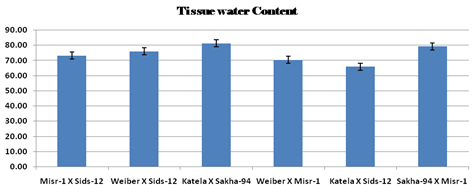
Figure 7 Effect of 20% PEG6000 on Tissue Water Content of tested wheat inbred lines (all means [± S.E.] are significantly different at P<0.05).
Studies of correlation between several variables (Table 2) revealed a favourable and highly significant relationship between seedling length and vigour index. Our study found a strong correlation between the characteristics we provided, suggesting that increasing seedling length would likewise boost vigour index. In addition, root numbers with seedling dry weight and seedling fresh weight with vigor index showed positive and significant correlation. Similar results were obtained in Ahmed et al,28 they noticed a correlation between seedling length and germination rate. Additionally, a number of studies have shown that the drought reaction of seedlings and the drought response of mature plants were fairly well correlated.29-31 Besides that, there was a fair amount of correlation between the drought responses of adult plants and seedlings.30-32
|
Seedling Length |
Root Numbers |
Seedling Fresh Weight |
Seedling Dry Weight |
Germination Percentage |
Vigor Index |
Root Numbers |
0.312 |
|||||
Seedling Fresh Weight |
0.689 |
0.594 |
||||
Seedling Dry Weight |
0.317 |
0.771* |
0.472 |
|||
Germination Percentage |
-0.165 |
0.412 |
0.267 |
-0.12 |
||
Vigor Index |
0.990** |
0.39 |
0.744* |
0.321 |
-0.024 |
|
Tissue Water Content |
0.464 |
0.251 |
0.645 |
-0.211 |
0.709 |
0.567 |
Table 2 Pearson correlation matrix among studied parameters
**Correlation is significant at the 0.01 level (2-tailed)
*Correlation is significant at the 0.05 level (2-tailed)
To evaluate the degree of similarity and dissimilarity among examined genotypes against induced 20% PEG6000, the Euclidean Similarity Index was used (Figure 8). The results indicated two clusters. The first cluster illustrates (Sakha-94 x Misr-1), (Katela x Sids-12) and (Weiber xMisr-1). Meanwhile, the second cluster viewed (Weiber x Sids-12), (Katela x Sakha-94) and (Misr-1 x Sids-12). These clusters had a stable performance in 20% PEG6000 stress, which provides visibility performance response during the experiment. Therefore, similarity index (Euclidean) was used to identify superior tolerant genotypes under salinity stress conditions for accuracy and reliability index.33
Overall, our finding showed that the inbred lines (Sakha-94 x Misr-1) and (Weiber x Sids-12) demostrated highest drought tolerant because they did not statistically significantly reduced under 20% PEG6000.
In regard to the previously mentioned findings from the current study, it's possible to conclude that 20% PEG6000 osmatic stress has a positive significant effect at early seedling growth, which helps to promote wheat seed germination and seedling growth in drought-stressed conditions.
This work has been supported by the Genetics Dept., Faculty of Agric., Sohag Univ., Sohag, Egypt.
Authors declare that there is no conflict of interest.

©2023 Ismail, et al. This is an open access article distributed under the terms of the, which permits unrestricted use, distribution, and build upon your work non-commercially.